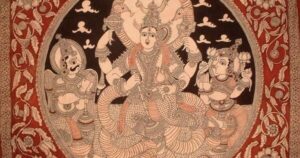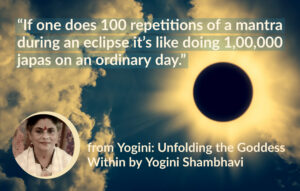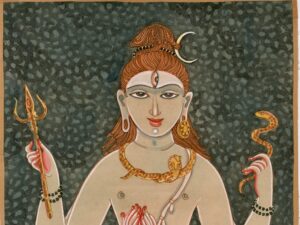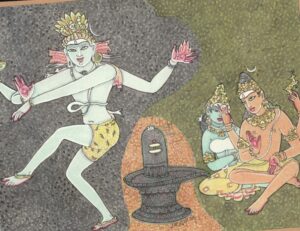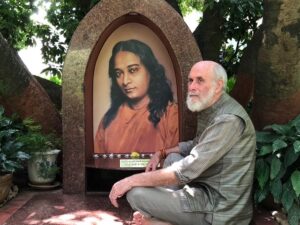Ananda is one of the key terms of Yoga and Vedanta, and like many of these often misunderstood. Ananda is translated as bliss, though it has no real equivalent in the English language. Bliss is a helpful approximation but can be misleading.
Ananda is composed of the prefix ‘aa’ indicating a superlative level, and nanda meaning joy, happiness, contentment or delight. Ananda refers to the deeper and timeless dimension of happiness, not just a higher degree of the joys that we normally experience in life.
The first thing to understand is that Ananda is not a dualistic emotion like emotions in general. Ananda is not a high that is connected to a low. Ananda is a non-dualistic state of awareness, Chidananda. It is a unitary state of feeling/knowing/seeing and being, in which we experience the essence, peace and delight that is the ground of all existence beyond time and space.
Emotion in the ordinary sense is a rajasic or tamasic state of turbulence or attachment that is transient in nature. An emotional high must alternate with an emotional low. The more extreme our emotional highs so will become the corresponding emotional lows. Emotion is a dualistic reaction of the ego and reflects bodily pleasures and instincts as well as personal social interactions that we find attractive or repulsive. Ananda is beyond all embodiment or mental conditions, one with the inner Seer or Atman and through it one with all of existence.
Ananda, Shanti and Samadhi
Ananda is not a denial of sorrow or pain but a transcendence of them. Ananda is a fullness of feeling in which we can discover our true Self in all beings and an eternal meaning in all of our changing experiences. Those who have that inner Ananda cannot be disturbed by sorrow or pain in body or mind. They can experience all that life has to offer, extracting the essence of creative delight behind the universal movement on all levels.
True Ananda arises from Shanti, inner peace, tranquility and serenity, calm, contentment and concentration. If one does not have inner peace, no true or lasting Ananda is possible, though emotional highs can be there for a time.
True Ananda is not induced by any external stimulation, substance or activity, including any type of drug or media influence. It is self-contained and manifests spontaneously of its own accord beyond any external karma, personal or material influences. Yet all the happiness we experience outwardly is a reflection or shadow of the eternal Ananda within that is unlimited.
In the context of deeper Yoga practices, Ananda relates to Samadhi , the yogic state of unitary consciousness and is often a synonym for it. Nirvikalpa Samadhi, the Samadhi that transcends all the activities of the mind, is also the highest Ananda. In this regard, the mind and all of its emotional and mental fluctuations, even those of an apparently happy nature, bring only sorrow in the end. Yet the inner Self that observes the mind has its own Ananda that ever remains in all the difficulties and ups and downs of life.
Discovering Ananda Within
Ananda in this true higher sense is not an experience of the mind. Ananda is only possible when we go beyond the mind. The very nature of the mind is turbulence and sorrow. Thought never brings us happiness, though it may pursue happiness. Only thought free awareness can do that. Ananda is the nature of pure consciousness like a mirror, not a fluctuation of the mind. Pure Ananda is a state of Being, not any experience in the realm of time, but when we touch the eternal behind our lives.
There is the related term of Anandamaya kosha, the innermost of the five koshas or coverings of the embodied soul or Jivatman. We experience this kosha mainly in the state of deep sleep, but we touch upon it whenever we feel happiness, beauty or delight. Yet the true Ananda transcends this Anandamaya kosha and allows us to find harmony in all. Anandamaya kosha is a step to the pure Ananda beyond all the koshas.
Our fundamental mistake in awareness that we make is that we confuse the pleasure or happiness that we experience from external objects as the source of that joy, when in fact it is only allowing us or triggering us to experience our own inner joy reflected on the object. We can hold to that inner light of Ananda and go beyond all suffering by seeing that essence and letting go of the object. Ananda is the ultimate essence of all life experiences. Indeed if we did not feel some degree of Ananda we would not want to live at all. But to really experience Ananda we must go to the core of our awareness beyond all outer influences.
We can compare Ananda with art. Art teaches us to experience the deeper essences of feeling and sensation behind outer objects. A bowl of fruit on a table is not a bowl of fruit on a table for an artist but an element of design evoking a beauty that transcends its constituent forms. Ananda is the ultimate beauty and delight that any artistic rendering can intimate or evoke.
How is it that we are not better connected with the Ananda inherent in our own inner Being, given that it is where we can find the ultimate happiness? It is because of the ignorance of the human mind, the ego, dualistic forces of attraction and repulsion, and the addictions that arise from it which keep us looking for Ananda on the outside.
How do we discover true Ananda? That is the goal of true Yoga Sadhana and the cultivation of Samadhi, the yogic state of unitary Awareness. It also means being willing to let go of our sorrow. True Ananda dwells within us if we can let go of external attachments and return to the core of our being that is one with all.
Remember the Ananda that is your true nature, even in the midst of the turbulence and distraction that the outer world abounds in! Do not just seek Ananda, reclaim the Ananda within you!
David Frawley (Vamadeva Shastri)

